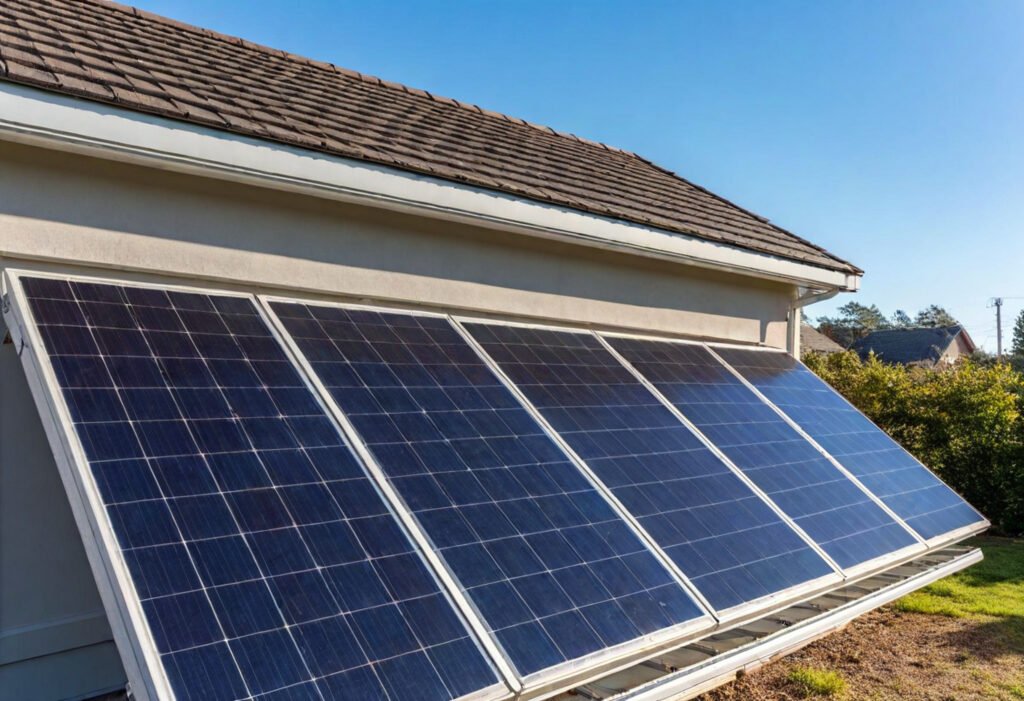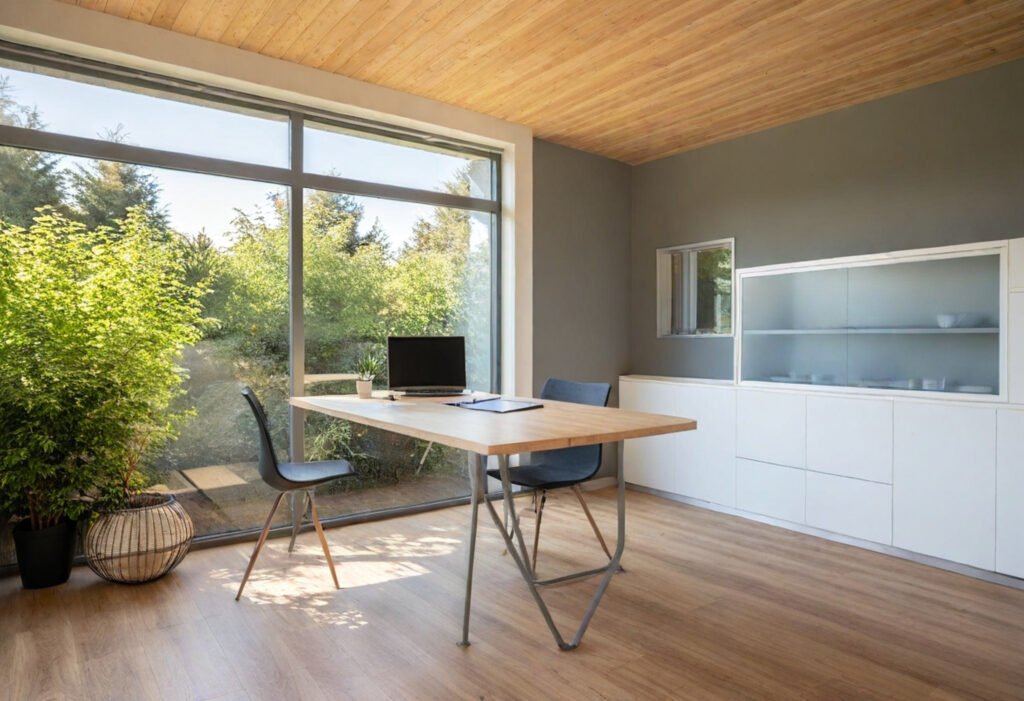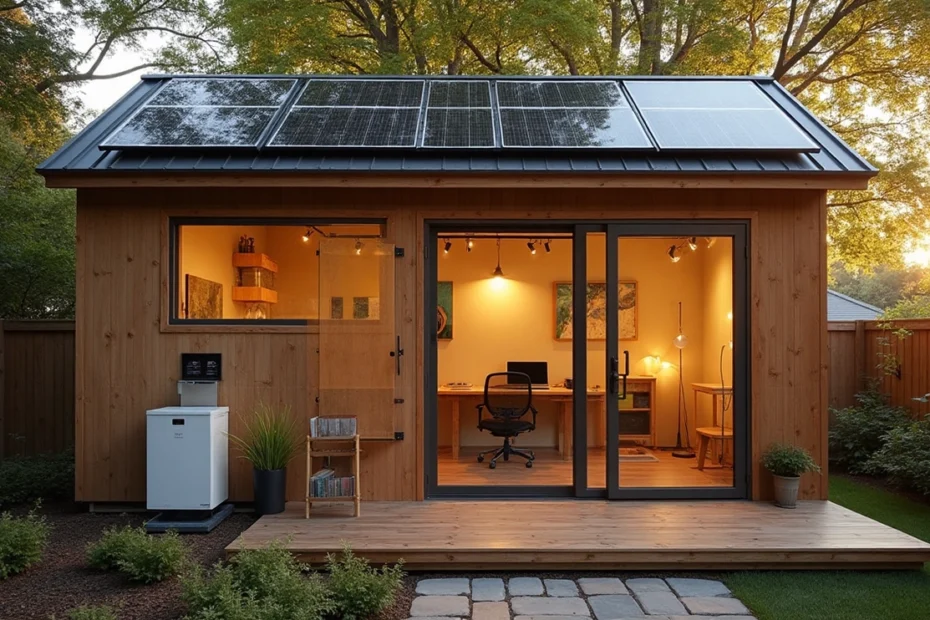A solar-powered shed might be your perfect home office solution, and it costs way less than you’d expect. My research shows that an off-grid workspace setup runs about $2,500 – a budget-friendly choice for many homeowners. The value becomes clear when you see that simple solar power systems for sheds start at just $140.
The standard setup has four 100-watt photovoltaic panels with battery storage systems like those in golf carts. Tests prove that a 400-watt setup with 300 amp hours of batteries powers various tools and appliances through a standard household plug-in inverter. On top of that, these systems can grow – the same charge controller handles up to 400 more watts of solar panels without needing upgrades.
This solution stands out because it combines energy independence with productivity. Your solar workspace boosts creativity and provides reliable power. It even works as backup power for home essentials during outages. Let’s explore how you can plan, build, and optimize your backyard solar sanctuary efficiently and comfortably.
Planning Your Solar-Powered Shed Office
A backyard shed can become a productive, comfortable, and energy-efficient solar-powered office with proper planning. Your workspace will thrive throughout the year when you prepare it right.
Choosing the right shed location
The perfect spot selection is a vital factor to maximize energy production in your solar-powered office shed. Your ideal location should get unobstructed sunlight most of the day, especially between 10 AM and 4 PM. People living in the northern hemisphere should position their shed’s roof facing south to get maximum sunlight. Avoid placing your shed under trees or overhangs because bird droppings and debris will reduce panel efficiency. The shed’s roof must be strong enough to support the weight of solar panels. These panels add weight similar to an extra layer of roof shingles.
Assessing your power needs
You should calculate your office’s electricity requirements before installing solar equipment. A typical backyard office needs about 2.7 kWp DC to power the workspace fully. Here are the common office equipment power requirements:
- Electric heater: 2000W-3000W
- Desktop computer: 100W-250W
- LED lights (4 x 10W): 40W
- Coffee machine: 600W
- Printer/scanner: 100W-200W
- Ceiling fan: 50W-100W
- Laptop chargers: approximately 10W
The watt-hours needed come from multiplying each item’s wattage by its daily usage hours. To cite an instance, see how 20W bulbs lighting your shed for five hours will need 100 watt-hours of electricity.
Understanding solar power for shed use
Several components work together in a complete solar system for your shed. Solar panels capture sunlight and convert it to DC electricity that batteries store to provide consistent power during cloudy days or nighttime. A charge controller manages electricity flow from panels to batteries and optimizes battery life by preventing overcharging. An inverter then changes DC electricity into AC power that most office equipment can use.
A 200-watt solar power system will run most small sheds efficiently, using either one large panel or two 100-watt panels. The 200W panel produces about 700-800 watt-hours of electricity daily in favorable conditions, which powers LED lighting and small devices adequately.
Setting Up the Solar Power System

The planning phase is complete. Let’s get started with the actual installation of your solar system. You’ll find the process straightforward when you follow the right steps and safety measures.
Installing solar panels on the roof
Rigid solar panels work best for rooftop installations. They provide durability and efficiency. Always cover panels with opaque material during installation so they don’t generate electricity while you work. Your panels need secure mounting with proper racking systems anchored to your roof structure. DIY kits make installation more available since they include the needed mounting hardware. Roofing sealer around lag screws prevents leaks and creates a weather-tight seal that will work for years.
Connecting the charge controller and inverter
The connection order matters by a lot for safety reasons. Start by connecting the battery to the charge controller. Match positive and negative terminals carefully. Next, connect the solar panels to the controller. Make sure you match the polarity to protect your components. The final step links your inverter straight to the battery bank with proper polarity. This careful sequence helps you avoid electrical arcing and system damage.
Battery storage and safety tips
The right battery placement is a vital part of system longevity and safety. Your batteries and electrical components need a dedicated space with good ventilation. Poor storage can lead to fire hazards. Outdoor battery setups need models rated for weather resistance (IP65 or higher). The setup should let you access components easily for maintenance checks.
These safety measures must be followed during installation:
- Wear protective equipment and insulated gloves when working with electrical connections
- Don’t disconnect components under load
- Keep connectors clean and dry
- Leave enough space (minimum 10cm) between panels and the roof surface for ventilation and fire safety
Your careful attention to these installation details means your shed will soon make use of clean solar energy to power your workspace.
Designing a Productive and Comfortable Workspace
“The shed is silent. I wish I’d built it sooner!” — Jeremy, Homeowner and solar-powered shed office builder featured by Tuff Shed
Your solar-powered shed needs a comfortable interior since you’ll spend many hours working there. The right setup boosts both productivity and energy efficiency.
Insulation and temperature control
Proper insulation is the key to energy efficiency in your off-grid workspace. Rock wool insulation provides excellent thermal performance with R14-R15 values for standard 2×4 walls. Rock wool works better than fiberglass and doesn’t cause breathing problems. You can add 2″ of foam board insulation over the studs to break thermal bridges for maximum effectiveness.
Your solar power shed setup needs careful temperature control planning. A well-insulated 15×15 building typically needs around 4500 BTU for heating. Mini-split heat pumps offer the quickest solution and consume approximately 4.5 kWh to heat an office for 8 hours at design temperature. High temperatures can substantially reduce productivity during summer months.
Lighting options for all-day work
Good lighting affects your work performance directly. Blue-enriched light bulbs help reduce daytime fatigue and improve creative thinking,g according to studies. The ideal 500-750 lux illumination helps minimize eye strain. Natural light saves energy and improves mood, so position your desk to get maximum sunlight. LED fixtures combined with solar power create an eco-friendly lighting system that needs almost no maintenance.
Desk, seating, and storage layout
Your long-term comfort and health depend on workspace furniture. Back pain from extended sitting can be prevented with an ergonomic chair’s lumbar support. Look for these features:
- High back support to prevent hunching
- Adjustable height allowing feet to rest flat
- Proper width and depth for comfortable seating
An adjustable desk enhances your ergonomic setup and lets you switch between sitting and standing positions. Start with 30-60 minutes of standing daily and gradually increase as your body adapts. This arrangement helps reduce shoulder pain while making the most of your limited space.
Smart Features and Monitoring Tools

Smart technology can change your solar-powered shed from a basic workspace into an intelligent environment that manages itself. These smart features help you control your power system better and keep it running at its best throughout the year.
Adding a battery monitor and shunt
A battery monitor with a shunt shows you exactly how much energy you have left. Your shunt connects between the battery’s negative terminal and loads, while positive lines go straight to the battery. This setup tracks energy as it flows both ways. You’ll need to fine-tune the monitor after installation. Just hold the arrow buttons to set the battery percentage and program settings like battery capacity and voltage disconnects.
Most solar-powered sheds work well with a 100- 200A monitor. This device becomes your power command center and displays the exact power left in your batteries.
Remote control and automation options
You can manage your shed’s solar power system from anywhere with remote capabilities. Advanced controllers help you adjust battery settings, plan power usage, and keep essential equipment running when power runs low.
These features let you:
- Use power when solar energy peaks
- Save money by consuming power when grid prices drop
- Charge batteries automatically before bad weather hits
Some systems can even predict weather patterns. They spot incoming storms and fill up your batteries before possible power outages.
Bluetooth and app-based monitoring
Your smartphone becomes the most convenient way to track everything. Bluetooth modules connect to your charge controller and turn your phone into a complete system dashboard. These modules work with easy-to-use apps that show you live performance data.
The apps display power flow with visual guides, create comparison graphs, and help you understand usage patterns. They break down your energy habits clearly and show ways to improve. These systems check how well everything works, show power generation daily, monthly, or yearly, and quickly spot any issues.
Yes, it is amazing how this smart technology creates endless battery life without changing how you use your devices. Just keep them in well-lit indoor areas for constant power.
Conclusion
Solar-powered shed offices offer an elegant solution for remote workers who want both productivity and sustainability. A well-planned backyard workspace delivers amazing value at a price point of $2,500, which is available to many. These self-contained offices give you the perfect mix of independence and functionality.
Your investment in a solar-powered shed office brings rewards beyond just workspace – it creates a sanctuary that blends energy efficiency with comfort. The 400-watt solar setup and battery storage can power your office equipment while staying off-grid. The right insulation and smart design turn a simple garden structure into a cozy year-round environment.
This system’s beauty comes from how easy it is to scale up. You can add more panels as your needs grow without overhauling the entire setup. Smart monitoring tools help you track available power, which lets usage patterns develop on their own.
A custom-designed space that creates its clean energy gives you satisfaction that regular home offices can’t match. The original planning pays off with years of productive, comfortable workdays, whatever the weather brings. A solar-powered shed office proves to be practical for anyone who needs to escape household distractions or reduce their carbon footprint. This solution deserves a serious look.
